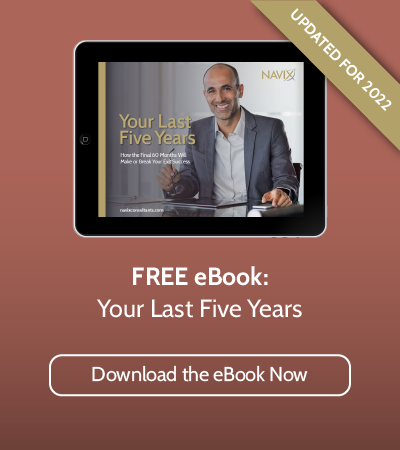By: Patrick Ungashick

Time after time, client after client, research study after research study, the answer remains the same—business owners’ number one goal at exit is to achieve their financial win, whatever amount that might be. In our experience, the most common financial goal is to reach financial freedom, which we define as getting to the point where working is a personal choice, not a necessity. Money cannot buy happiness, but business owners who have successfully reached financial freedom seem to smile on a regular basis.
How exactly does one achieve financial freedom, and just as importantly, how does one make sure that you stay there after you exit?
Many business owners’ greatest financial fear is to exit from the company with the belief they have enough to be financially free for life, only to find out later—when it’s too late—that the nest egg is not enough. This can happen either because of bad math before you exited, or bad advice and decisions after you exited.
Here are the four most important steps and tactics to make sure you reach financial freedom by the time of your exit and ensure that you stay there afterwards:
- Calculate your Exit Magic Number™ - This exercise calculates how much capital you need to receive from the business between now and the exit to achieve personal financial freedom. In other words, it tells you exactly how much you need to reach financial freedom, and whether or not you are on track to get there. Your Exit Magic Number™ is the most important number to you as a business owner. It calculates the net amount you need to achieve financial freedom after you exit your business.
In our experience, most owners don’t know their number or have a number in their head that is usually wrong—by many millions of dollars. Too often, financial advisors miscalculate it. It has nothing to do with your company’s value; if your business’ value is how much you have, your Exit Magic Number™ is how much you need.
It’s critical to know your number accurately. This short video introduces you to a tool we offer to help you calculate and track your Exit Magic Number™. - Monitor Annually – Once you know your Exit Magic Number™, we recommend you update the analysis and track your number, not less than annually. Update the analysis more often as you get closer to exit, to refine the results. As a resource to help, refer to this white paper to understand the importance and process of calculating the Exit Magic Number™, to guide you in determining yours.
- Hit Your Exit Magic Number™ at Exit – Whether you are exiting by way of sale, or passing the business to the kids, or some other exit strategy, it is of paramount importance that you reach your Exit Magic Number™ when you finally do exit. If you come up short, that means you must continue working to earn some additional income, or you may have to consider reducing your lifestyle costs. Too many owners focus on the total company value, especially if they are selling. It’s nice and makes you feel good to hear your company might be worth XX millions, but what matters is what you net at exit, and whether that is enough to reach your financial win. Said another way, your company value is vanity, your Exit Magic Number™ is sanity.
- Have a Sound Investment Plan and Team for Life After Exit – Once you have exited, now the challenge becomes how to stay financially free. For many owners, financial life after exit is new and initially uncomfortable. Your world changes from having a dominant financial asset (your business) that is controlled by you, that you touch every day, to a new and perhaps uncomfortable world of intangible assets such as stocks, bonds, mutual funds, and so on. These new assets also do not seem to follow the same rules and patterns that your former company did.
Managing financial affairs after your exit is an ongoing process and responsibility. There are foundational elements to maintaining financial freedom, once you have reached it. Consider the following checklist of eleven issues to address as part of your plan. Read each statement. Any that you disagree with will reveal an area of planning that you may need to address to reach and maintain financial freedom post exit:
- I have confidence in how I will invest my assets to meet my post exit living expenses and other financial needs.
- I am comfortable with the investment risk I am taking to meet my post exit income needs.
- I took adequate steps to address inflation and its potential erosion of my purchasing power.
- My assets are sufficiently diversified to reduce potential investment risk.
- I have confidence in my investment advisors and managers, and have clear expectations for how I will work and communicate with them.
- I have adequate cash on hand for emergency reserves (generally advisable as six month's overhead).
- I adequately addressed my post exit medical insurance needs.
- I updated my estate planning to reflect the changes to my situation after my exit.
- I took adequate steps to address any assisted living needs that I may have in the future.
- I adequately addressed post exit income tax planning.
- I have a strategy to monitor and update my post exit personal financial plans as needed.
Put these four steps together, and you will have a plan for pursuing and reaching financial freedom at exit, and keeping it once you get there. It takes work to create this plan, but the work is worth it. You probably have worked too hard not to give yourself every opportunity achieve this success.









